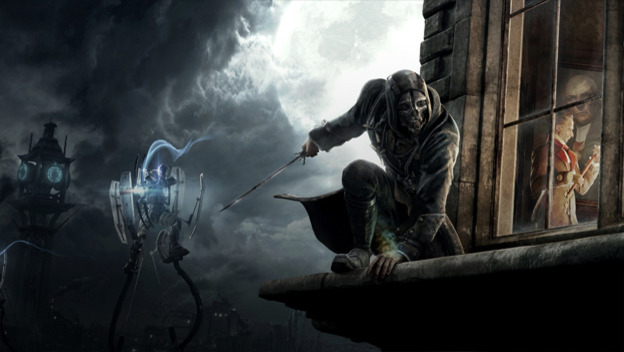In 2009 Ubisoft released their first Tom Clancy inspired dance game. The cover to Tom Clancy’s Splinter Cell: Conviction featured a young looking Fisher posing atop a nameless spider-eyed soldier. I thought Ubisoft’s decision to create a dance game in the Clancy universe was a bit of an odd one, but also very inventive–this could be the beginning of a whole new genre! Action/dance, or stealth/dance. So I was surprised when the game was released and described by gamers around the world as an action-adventure/stealth game.
Had I missed something? I’d watched all the previews, I’d played the full length demo… and it was a dance game, wasn’t it? It was a case of navigating Fisher around the environment, waiting for the enemies to line up with the gaps in a broken window, then pressing the execute button and watching the action unfold. It was Dance Dance Revolution without the arrows. Oh, but wait, there were arrows. Though perhaps I’m doing Conviction a disservice; the game still had areas of darkness in which you could hide from the enemy and Fisher often started the mission with a silenced weapon rather than a shotgun – but gone was the ability to hide bodies, gone was the ability to knock guards unconscious, and CQC was reserved primarily for torture-porn scenes.
Maybe the previous game in the series was too difficult? In fact, that’s exactly what Ubisoft thought. “Ubisoft didn’t want us to make another Double Agent or another Chaos Theory […] I think the issue that Ubisoft identified was that, out of everybody that is attracted by the fantasy of playing Sam Fisher, when they actually get to play it, we lose a lot of people. Stealth, I think, has always been delivered as very hardcore gameplay.” said Max Beland, Creative Director of Conviction , in an interview with Edge-Online before pointing out the obvious, “Ubisoft obviously wanted to see if there was a way to please even more people, to get more people interested in the brand and the genre.” Money, folks. Why was Conviction a dance game? Because Ubisoft thought there might be money in it, surprise surprise. But Beland was set on finding the golden mean, asking, “can we make stealth something that more people want to play, can we address the issues that people have with the genre?”
“We talked to a lot of gamers and there were a lot of themes that were coming back all the time: stealth is punitive, stealth is slow. It was funny because when you watch movies they’re not that,” he continues, “James Bond and Jason Bourne run fast, they don’t make noise, they kill one, two, three or four guys super quickly and silently with a sound suppressor, so it’s a lot more dynamic. So we needed something like that.” But the Bond and Bourne films are action/thrillers and the sound suppressor is often traded for an enemies AK or a stray rocket launcher halfway through the film. That’s not stealth. That’s really not stealth. From Merriam-Webster, stealth is , “the act or action of proceeding furtively, secretly, or imperceptibly […] of being furtive or unobtrusive”, which is very different from action, defined as , “the bringing about of an alteration by force […] the most vigorous, productive, or exciting activity in a particular field, area, or group”.
That’s not to say that the two can’t function in the same space. Last year’s Dishonored with its combination of smooth blinks, parkour and neck-hugging mechanics proved that action and stealth could get along, and with a score of 91 over at Metacritic it did it rather well. Though it wasn’t as deep and difficult as the Thief series, it managed to circumvent Beland’s Dance Dance approach to stealth/action. So what did Dishonored do right that Splinter Cell did wrong? It contained old school stealth mechanics–dragging bodies, the need to often get up close and personal, puzzling and often complex environments–and then simply added action elements to it. Want to run around bolting people in the face? You can do it. Want to remove the HUD and pretend you’re an assassin? You can do it.

Dishonored was a new title, it wasn’t the continuation of an old series so it was able to carve itself into whatever genre it liked, but then there’s the new Thief . The Thief series basically invented stealth gaming as we know it, and featured extensive body dragging, obtuse maps, complex environments, and a very weak protagonist. The old Thief games were stealth games, while the new Thief is trying to capitalize on the interest in the action/stealth genre, and fans of the series aren’t happy about it. The difference between stealth and action/stealth can be as large or as small as you like, and perhaps hardcore Thief fans are worried that the new Thief is going to be the next Conviction rather than Dishonored , narrowing the player into action-orientated scenarios like some militaristic dictator.
So is action/stealth an evolution of the stealth genre? Is it regressive? Or is it something altogether different? I’d argue passionately that it can be all of the above, but that it’s a matter of balance. Games developers can go the Conviction , Dishonored , or Metal Gear Solid route, or make something entirely new. The difficulty is achieving a balance between the two genres by making it challenging enough for stealth gamers, and packing it with enough explosions to please the COD generation. Oh, and if you’re going to make the next game in a video game series fit into a different genre, then tread carefully.
